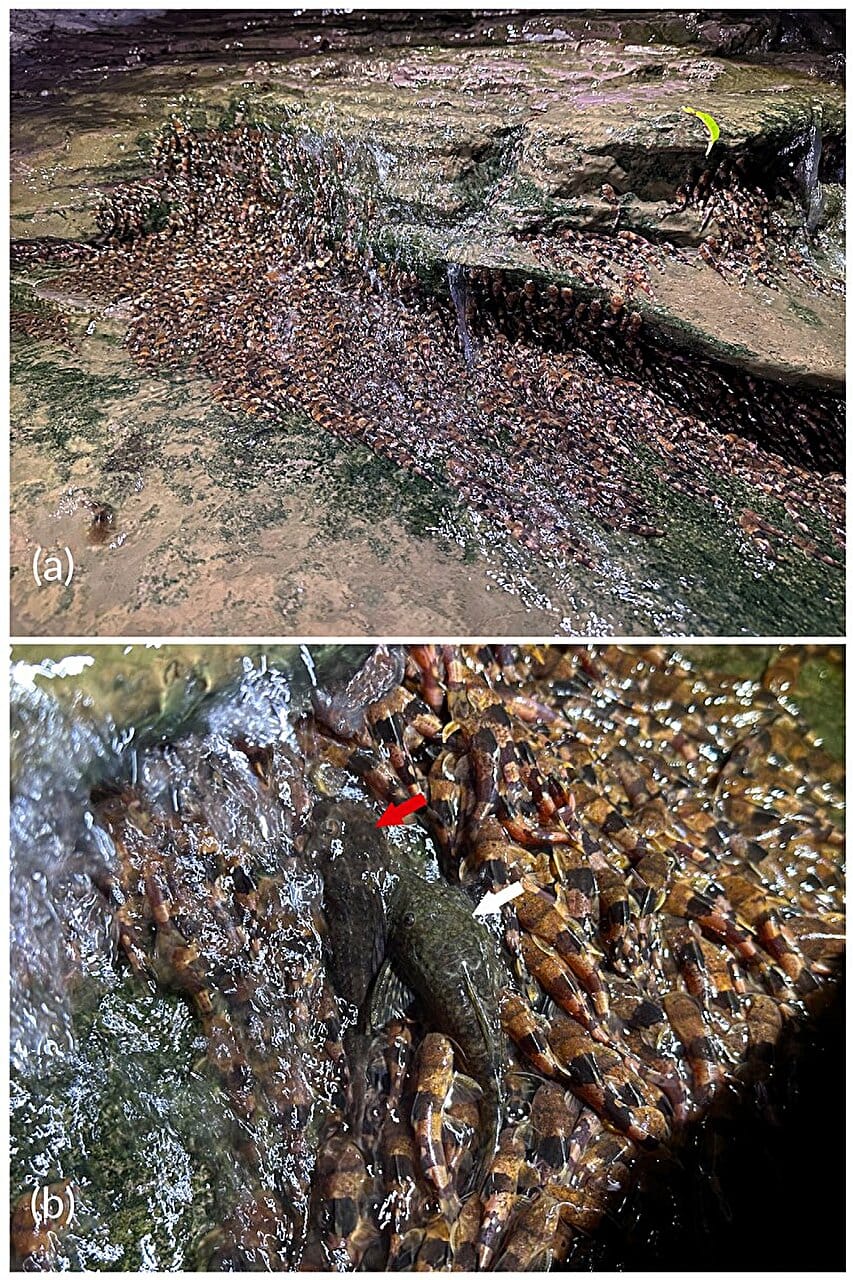In the heart of southern Brazil, nature has recently staged a performance so unexpected that even seasoned biologists were caught off guard. Beneath the cascading whitewater of the Aquidauana River, thousands of bumblebee catfish — the striking orange-and-black Rhyacoglanis paranensis — were filmed doing something few fish are ever seen doing: climbing waterfalls.
This spectacle, documented in November 2024 and described in a study published in the Journal of Fish Biology, marks the first recorded instance of the species scaling such challenging obstacles in such large numbers. Until now, these catfish were considered rare, elusive inhabitants of fast-flowing rivers, their behavior largely hidden from human observation.
Discovery by Chance, Science by Persistence
The story began when Environmental Military Police from the Brazilian state of Mato Grosso do Sul spotted the fish in action. The scene was almost surreal — small catfish clinging to slick, vertical rock faces behind waterfalls, pushing themselves upward against the relentless force of rushing water.
The officers measured the climbs at heights between one and four meters — no small feat for a fish rarely exceeding a few dozen centimeters in length. Within a week of the first sighting, a team of Brazilian researchers arrived to investigate, eager to capture both video and data before the rare event ended.
Timing Is Everything
Over several days of observation, scientists noticed a clear pattern. During the scorching afternoons of the Brazilian spring, the catfish were nowhere to be seen on the rocks. Instead, they hid beneath shaded ledges and under submerged stones, conserving energy and avoiding the hottest part of the day.
Then, as the sun dipped toward the horizon and shadows lengthened across the river, the first climbers appeared. One after another, they pressed their paired fins wide, moved their tails in slow, powerful sweeps, and inched upward. Scientists believe the fish may also use a suction-like mechanism to cling to smooth surfaces, allowing them to pause without being swept away.
Why Climb at All?
While the exact reason for this remarkable migration remains uncertain, the researchers have a compelling theory: reproduction. Both males and females were seen making the climb, most of them mature adults. The timing — at the very start of the rainy season — also matches the breeding migrations of other river fish in the region.
By moving upstream, the catfish may be seeking specific habitats for spawning — areas with suitable currents, water chemistry, and shelter for their young. This behavior could be part of an ancient survival strategy, repeated for countless generations, yet almost entirely hidden from science until now.
A Mystery Wrapped in Stripes
Part of the fascination with this event comes from how little is known about Rhyacoglanis paranensis. Their small size, preference for turbulent waters, and scattered distribution make them difficult to track and study. Until this waterfall-climbing display, scientists had few opportunities to observe them in large groups or in a natural migration.
Adding to the intrigue, three other fish species were observed climbing alongside the bumblebee catfish, suggesting that these rock-scaling migrations may be a broader, community-level phenomenon — a seasonal choreography involving multiple species navigating the same river obstacles.
Conservation on the Rocks
While the sight of thousands of catfish hauling themselves skyward is captivating, the study’s authors stress that it carries a serious message. Such migrations depend on uninterrupted river systems. Dams, pollution, and habitat loss could block these fish from reaching spawning grounds, putting their survival at risk.
“These findings highlight the importance of field observations in understanding small migratory fishes’ ecological role and conservation needs,” the researchers write. “Particularly in the context of potential threats posed by habitat fragmentation and river damming.”
If waterfall climbing is essential to the species’ life cycle, any disruption could be devastating. Understanding when and where these migrations occur will be critical for designing conservation strategies, such as maintaining fish passages or protecting key sections of river habitat.
What Comes Next?
The team behind the discovery says more research is urgently needed. Future studies could focus on the biomechanics of the climb — the interplay of muscle strength, fin positioning, and suction forces — as well as the broader migratory patterns of the species.
Such work will not only deepen our understanding of this rare catfish but could also shed light on the hidden journeys of other small, overlooked freshwater fish. After all, the rivers of the world are full of travelers, many with stories that remain untold.
For now, the images of thousands of tiny orange-and-black bodies defying gravity remain a vivid reminder of nature’s ingenuity — and of the delicate balance that allows such spectacles to unfold, season after season, in the wild heart of Brazil.
More information: Manoela M. F. Marinho et al, Bumblebee on the rocks: Massive aggregation, migratory and climbing behaviour of a small Neotropical catfish, Journal of Fish Biology (2025). DOI: 10.1111/jfb.70158






